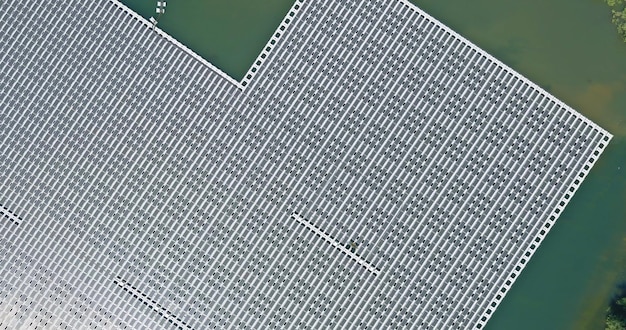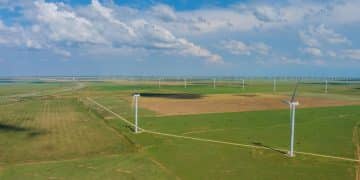US Gov Invests $2 Billion in Clean Energy Storage: A Deep Dive

The US Government has announced a significant investment of $2 billion in clean energy storage solutions, aiming to accelerate the development and deployment of technologies that will enhance grid reliability and support the nation’s transition to a clean energy economy.
The landscape of clean energy is set for a major transformation as the US Government announces a $2 billion investment in clean energy storage solutions. This initiative marks a pivotal moment in the nation’s commitment to sustainable energy and grid modernization.
Understanding the US Government’s $2 Billion Clean Energy Storage Investment
The US government’s recent announcement of a $2 billion investment in clean energy storage solutions is a landmark move. It signals a strong commitment to upgrading the energy infrastructure and ensuring a more sustainable and resilient energy future.
This investment is not just about deploying new technologies, it’s about fostering innovation, creating jobs, and securing America’s position as a leader in the global clean energy market. Let’s take a closer look at what this initiative entails and why it’s so important.
Key Goals of the Investment
The investment aims to address several critical challenges in the energy sector, including the intermittency of renewable energy sources and the need for a more reliable and flexible grid. Here are some key goals:
- Enhance grid reliability by ensuring a stable energy supply during peak demand and periods of low renewable energy generation.
- Accelerate the deployment of clean energy technologies by reducing costs and improving performance.
- Support job creation in the clean energy sector through research, development, and manufacturing activities.
- Reduce greenhouse gas emissions by enabling greater use of renewable energy sources and reducing reliance on fossil fuels.
Target Areas for Investment
The $2 billion investment will be strategically allocated across various areas within the clean energy storage sector. Here are some of the focal points for this funding:
- Advanced Battery Technologies: Improving the energy density, lifespan, and safety of lithium-ion and other advanced battery technologies.
- Flow Batteries: Supporting the development and deployment of flow batteries, which offer long-duration storage capabilities.
- Pumped Hydro Storage: Enhancing existing pumped hydro storage facilities and exploring new sites for development.
- Thermal Energy Storage: Investing in technologies that store energy in the form of heat or cold for later use.

Ultimately, this investment reflects a comprehensive strategy to modernize the energy grid and ensure a sustainable and reliable energy future for all Americans.
The Significance of Clean Energy Storage Solutions
Clean energy storage solutions are increasingly recognized as crucial for the widespread adoption of renewable energy. They address the inherent variability of solar and wind power, ensuring a consistent and reliable energy supply.
Without effective storage, the potential of renewable energy sources cannot be fully realized. This investment aims to bridge that gap, allowing for a greater integration of renewables into the energy grid.
Addressing Intermittency
One of the primary challenges with renewable energy sources like solar and wind is their intermittency. Solar power is only available during daylight hours, and wind power depends on weather conditions. Storage solutions help mitigate this issue by storing excess energy generated during peak production times for use when demand is high or renewable energy generation is low.
Enhancing Grid Resilience
Energy storage also plays a vital role in enhancing grid resilience. By providing backup power during outages and emergencies, storage systems can help prevent disruptions and ensure a more reliable energy supply. This is especially important in areas prone to natural disasters or grid vulnerabilities.
Economic Benefits
Investing in clean energy storage solutions offers significant economic benefits. It creates new jobs in manufacturing, installation, and maintenance. Additionally, it reduces energy costs for consumers and businesses by optimizing energy use and reducing reliance on expensive fossil fuels. The benefits will be summarized below:
- Reduced energy costs for consumers and businesses.
- Job creation in the manufacturing, installation, and maintenance sectors.
- Increased energy independence and security.
The economic advantages of clean energy storage extend beyond direct financial savings, fostering innovation and economic growth.
Types of Clean Energy Storage Technologies
The clean energy storage sector includes a diverse range of technologies, each with its own strengths and applications. Understanding these technologies is crucial for appreciating the full scope of the government’s investment.
From batteries to thermal storage, these innovations are reshaping how we produce, store, and use energy. Furthermore, they ensure a gradual departure from traditional carbon-intensive methods of energy production.
Battery Storage
Battery storage is one of the most widely used and rapidly evolving clean energy storage technologies. Batteries can store electricity and release it when needed, making them ideal for grid stabilization and backup power. Lithium-ion batteries are currently the dominant technology, but research is ongoing to develop new and improved battery chemistries.
Flow Batteries
Flow batteries are another promising storage technology, particularly for long-duration storage applications. Unlike traditional batteries, flow batteries store energy in liquid electrolytes, which allows for greater scalability and longer lifespans. This makes them well-suited for grid-scale storage and balancing intermittent renewable energy sources.
Pumped Hydro Storage
Pumped hydro storage is a well-established technology that involves pumping water from a lower reservoir to a higher reservoir during off-peak hours and then releasing the water to generate electricity when demand is high. Although it requires specific geographic conditions, pumped hydro storage offers large-scale, long-duration storage capabilities.

These are just a few examples of the many innovative technologies that are transforming the energy storage landscape. The government’s investment will help accelerate the development and deployment of these solutions, paving the way for a cleaner and more sustainable energy future.
How the Investment Will Drive Innovation
The $2 billion investment is expected to act as a catalyst for innovation in the clean energy storage sector. By providing funding for research, development, and demonstration projects, the government aims to accelerate the pace of technological advancement.
This injection of capital will empower researchers, entrepreneurs, and businesses to push the boundaries of what’s possible. A future of energy storage and production is sure to be influenced by new research and development.
Research and Development
A significant portion of the investment will be allocated to research and development activities. This includes funding for universities, national laboratories, and private companies to explore new materials, designs, and manufacturing processes. The goal is to develop more efficient, cost-effective, and reliable energy storage solutions.
Demonstration Projects
The government will also support demonstration projects that showcase the potential of new technologies in real-world settings. These projects provide valuable data and insights that can help accelerate commercialization and adoption. By demonstrating the viability of innovative storage solutions, the investment can help overcome barriers to market entry.
Public-Private Partnerships
Many of the investment initiatives will involve public-private partnerships. These collaborations bring together the expertise and resources of both the public and private sectors to address complex challenges and drive innovation. Public-private partnerships can help accelerate the development and deployment of clean energy storage technologies by sharing risks and leveraging complementary strengths.
Innovation is the lifeblood of the clean energy sector. By fostering a culture of experimentation and collaboration, the investment can unlock new breakthroughs that transform the way we store and use energy.
Potential Challenges and How to Overcome Them
While the $2 billion investment represents a significant opportunity, there are also potential challenges that need to be addressed. Overcoming these obstacles will be crucial for maximizing the impact of the investment and ensuring its long-term success.
Here are some of the main hurdles on the path to a sustainable energy future supported by innovative clean energy storage solutions.
Cost Competitiveness
One of the primary challenges is ensuring that clean energy storage solutions are cost-competitive with traditional energy sources. While the cost of storage technologies has decreased significantly in recent years, further reductions are needed to make them economically viable on a large scale. Government funding and incentives can help bridge this gap and drive down costs through economies of scale and technological advancements.
Regulatory Barriers
Regulatory barriers can also hinder the deployment of clean energy storage solutions. Permitting processes, grid interconnection rules, and other regulations can be complex and time-consuming, slowing down project development. Streamlining these processes and creating a more supportive regulatory environment can help accelerate the adoption of storage technologies.
Supply Chain Issues
Supply chain issues, such as shortages of critical materials and components, can also pose a challenge. Diversifying supply chains, investing in domestic manufacturing, and promoting the development of alternative materials can help mitigate these risks and ensure a reliable supply of storage technologies.
- Diversifying supply chains
- Investing in domestic manufacturing
- Promoting the development of alternative materials
By proactively addressing these challenges, the government can create a more favorable environment for the growth of the clean energy storage sector and ensure that the investment delivers its intended benefits.
The Future of Clean Energy Storage in the US
The $2 billion investment signals a bold step towards a future where clean energy storage plays a central role in the US energy system. This initiative is set to transform the energy landscape and realize the full potential of renewable energy sources.
The transformative effects of this investment are far-reaching and have a lasting impact on the whole economic and environmental landscape of the country.
Increased Renewable Energy Integration
With enhanced storage capabilities, the US will be able to integrate more renewable energy into the grid, reducing reliance on fossil fuels and lowering greenhouse gas emissions. This will contribute to a cleaner and more sustainable energy future for generations to come.
Grid Modernization
Clean energy storage will also play a key role in modernizing the grid, making it more resilient, flexible, and efficient. Advanced storage systems can help manage peak demand, stabilize the grid, and improve overall energy reliability.
Economic Growth and Job Creation
The growth of the clean energy storage sector will create new economic opportunities and jobs across the country. From manufacturing and installation to research and development, this industry has the potential to drive innovation and create a more prosperous and sustainable economy.
Here are a few key benefits to consider:
- Economic growth across various sectors.
- Increased job creation in technological and energetic fields.
- Modernization of grids to supply greener sources of energy.
The potential benefits are far-reaching, promising a cleaner, more resilient, and economically vibrant energy future for the US.
| Key Point | Brief Description |
|---|---|
| 💡 Investment Amount | US Government announces $2 billion investment. |
| 🔋 Storage Types | Includes battery, flow, pumped hydro, and thermal storage. |
| 🌱 Main Goal | Enhance grid reliability and sustainability. |
| 🏭 Job Creation | Expected to create new jobs in the clean energy sector. |
Frequently Asked Questions
▼
The primary goal is to enhance grid reliability by ensuring a stable energy supply, especially during peak demand and periods of low renewable energy generation, contributing to a more sustainable energy future.
▼
The investment will target advanced battery technologies, flow batteries, pumped hydro storage, and thermal energy storage, aiming to improve the efficiency and scalability of these solutions.
▼
By enabling greater use of renewable energy sources and reducing reliance on fossil fuels, this initiative is a step forward to lowering greenhouse gas emissions and promoting a cleanerenvironment.
▼
The investment stimulates job creation in the clean energy sector and reduces energy costs for consumers and businesses by optimizing energy use and diminishing dependency on fossil fuels.
▼
Energy storage provides backup power during outages and emergencies, preventing major disruptions and ensuring a reliable energy supply, vital in areas prone to natural disasters or grid vulnerabilities.
Conclusion
The US government’s $2 billion investment in clean energy storage solutions is a transformative step towards a sustainable and resilient energy future. By driving innovation, enhancing grid reliability, and fostering economic growth, this initiative promises to reshape the energy landscape and position the US as a global leader in clean energy.





